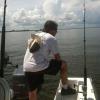whats up with a direct box

Member
Posts: 76
Joined: Mar 24, 2016
whats up with a direct box? is it really needed and what does it do? I've use one during many live gigs when I was playing bass, because keyboard player said I needed too, yep whatever. I still have it, should I use it for bass DAW recording?.. I don't know ?. never noticed much difference. Ideas and thoughts , opinions?. thanks 

+1
Member
Posts: 61
Joined: Dec 12, 2015
di box in a great simplification is necessary for transmission of unbalanced signals (without protective cable - GND), over long distances (stage - mixing console).
Signal conversion to symmetrical (balanced), increases the resistance of the signal to external disturbances.
It also allows to overcome the problem of "ground loop", by separating input and output signals. Sometimes unseparated in/out signals, are the cause of additional disturbances.
If there is no interference from the ground loop, I think there is no need for You to use DI BOX in Your home studio
Signal conversion to symmetrical (balanced), increases the resistance of the signal to external disturbances.
It also allows to overcome the problem of "ground loop", by separating input and output signals. Sometimes unseparated in/out signals, are the cause of additional disturbances.
If there is no interference from the ground loop, I think there is no need for You to use DI BOX in Your home studio
+4

Ernie Ball 2221 Regular Slinky Gitarrensaiten
Saitensatz für E-Gitarre

5,90 €
iThis widget links to Thomann, our affiliate partner. We may receive a commission when you purchase a product there.
Visit Shop

Member
Posts: 111
Joined: Nov 9, 2016
Yes!  But the quality of the DI box is crucial for it to have any effect
But the quality of the DI box is crucial for it to have any effect 
Besides the reasons PierreOghi stated:
2. MATCHING IMPEDANCE WHEN RECORDING
https://www.dawsons.co.uk/blog/why-use-a-di-box
Besides the reasons PierreOghi stated:
2. MATCHING IMPEDANCE WHEN RECORDING
https://www.dawsons.co.uk/blog/why-use-a-di-box
+3

Member
Posts: 76
Joined: Mar 24, 2016
now I know. thanks . gonna use from now on.
+2
SUPPORTER
Posts: 126
Joined: Jul 23, 2013
I use it regularly in my recordings, in addition to a model with preamplifier valves, and in addition to the technical explanation of Pierre for the stage and PA, in my case I increase the sound quality of my jams and a "cleaner" signal. It is the method that I usually use, and better respect to the sound interface USB cards or the basic recording in Mic or Line In in a computer.
If you can also record with an amplifier at home (it is not my situation for the neighbors) with a DI + Mic in amplifier is how you get the tone with more punch
https://www.youtube.com/watch?v=Q4MlUcO8fas
It's my amateur opinion
If you can also record with an amplifier at home (it is not my situation for the neighbors) with a DI + Mic in amplifier is how you get the tone with more punch
https://www.youtube.com/watch?v=Q4MlUcO8fas
It's my amateur opinion
+3

SUPPORTER
Posts: 862
Joined: Feb 14, 2018
Interesting thread here. @Mario, somehow your video doesn't want to play...
So what would be the ultimate solution then? High end class A ( like https://www.thomann.de/de/avalon_u5_mono_dipreamp.htm?ref=search_prv_10 ) or tube (like https://www.thomann.de/de/universal_audio_solo_610.htm ) DI/preamp into high end interface, something like https://www.thomann.de/de/rme_fireface_uc.htm ?
And would that make a difference against some stock USB audio interface? A difference one could easily *hear*? I've been out of the studios for too long (since the times of 24 track tape recorders), but I bet that yes - in such an environment you'd actually hear a difference...
@OliVBee: If you're reading this, you have an RME interface, right? Can you enlighten us perhaps?
Cheers,
Wolfgang
So what would be the ultimate solution then? High end class A ( like https://www.thomann.de/de/avalon_u5_mono_dipreamp.htm?ref=search_prv_10 ) or tube (like https://www.thomann.de/de/universal_audio_solo_610.htm ) DI/preamp into high end interface, something like https://www.thomann.de/de/rme_fireface_uc.htm ?
And would that make a difference against some stock USB audio interface? A difference one could easily *hear*? I've been out of the studios for too long (since the times of 24 track tape recorders), but I bet that yes - in such an environment you'd actually hear a difference...
@OliVBee: If you're reading this, you have an RME interface, right? Can you enlighten us perhaps?
Cheers,
Wolfgang
+2
Member
Posts: 61
Joined: Dec 12, 2015
@Mr Mario:
I'm very interested in what you wrote. Especially when it comes to sound, You have one of the best on wikiloops.
So I plan to do an experiment.
Unfortunately, the instrumental input in my interface is not balanced. Balanced inputs are LINE IN and MIC.
So I plan to lconnect my AMPEG SCR-DI preamp with a balanced output, to microphone input in the interface.
Does such a connection make sense to You?
I'm very interested in what you wrote. Especially when it comes to sound, You have one of the best on wikiloops.
So I plan to do an experiment.
Unfortunately, the instrumental input in my interface is not balanced. Balanced inputs are LINE IN and MIC.
So I plan to lconnect my AMPEG SCR-DI preamp with a balanced output, to microphone input in the interface.
Does such a connection make sense to You?
+3
SUPPORTER
Posts: 126
Joined: Jul 23, 2013
wjl wrote:
Interesting thread here. @Mario, somehow your video doesn't want to play...
So what would be the ultimate solution then? High end class A ( like https://www.thomann.de/de/avalon_u5_mono_dipreamp.htm?ref=search_prv_10 ) or tube (like https://www.thomann.de/de/universal_audio_solo_610.htm ) DI/preamp into high end interface, something like https://www.thomann.de/de/rme_fireface_uc.htm ?
And would that make a difference against some stock USB audio interface? A difference one could easily *hear*? I've been out of the studios for too long (since the times of 24 track tape recorders), but I bet that yes - in such an environment you'd actually hear a difference...
@OliVBee: If you're reading this, you have an RME interface, right? Can you enlighten us perhaps?
Cheers,
Wolfgang
Interesting thread here. @Mario, somehow your video doesn't want to play...
So what would be the ultimate solution then? High end class A ( like https://www.thomann.de/de/avalon_u5_mono_dipreamp.htm?ref=search_prv_10 ) or tube (like https://www.thomann.de/de/universal_audio_solo_610.htm ) DI/preamp into high end interface, something like https://www.thomann.de/de/rme_fireface_uc.htm ?
And would that make a difference against some stock USB audio interface? A difference one could easily *hear*? I've been out of the studios for too long (since the times of 24 track tape recorders), but I bet that yes - in such an environment you'd actually hear a difference...
@OliVBee: If you're reading this, you have an RME interface, right? Can you enlighten us perhaps?
Cheers,
Wolfgang
Hi Wolfgang
Repair the Youtube link
https://www.youtube.com/watch?v=Q4MlUcO8fas
The options that Thomann comments are professional (for the price ...) my system is simpler and works well in addition to much cheaper
I use the valve preamp towards the USB audio interface and with respect to the simple USB card that also sounds very good I find a fuller sound and more complete control of the signal through the preamplifier, especially in bass (or guitar) passives
Preamplifier
https://www.amazon.es/Behringer-MIC200-Preamplificador-behringer-mic200-eu/dp/B0002E51PI
USB Interface
https://www.thomann.de/es/focusrite_scarlett_solo_2nd_gen.htm?glp=1&gclid=CjwKCAjwl...
+1

Ernie Ball 2221 Regular Slinky Gitarrensaiten
Saitensatz für E-Gitarre

5,90 €
iThis widget links to Thomann, our affiliate partner. We may receive a commission when you purchase a product there.
Visit Shop
SUPPORTER
Posts: 126
Joined: Jul 23, 2013
PierreOghi wrote:
@Mr Mario:
I'm very interested in what you wrote. Especially when it comes to sound, You have one of the best on wikiloops.
So I plan to do an experiment.
Unfortunately, the instrumental input in my interface is not balanced. Balanced inputs are LINE IN and MIC.
So I plan to lconnect my AMPEG SCR-DI preamp with a balanced output, to microphone input in the interface.
Does such a connection make sense to You?
@Mr Mario:
I'm very interested in what you wrote. Especially when it comes to sound, You have one of the best on wikiloops.
So I plan to do an experiment.
Unfortunately, the instrumental input in my interface is not balanced. Balanced inputs are LINE IN and MIC.
So I plan to lconnect my AMPEG SCR-DI preamp with a balanced output, to microphone input in the interface.
Does such a connection make sense to You?
Hi Pierre
Thanks for your feedback!
The connection you propose is the one I use!! , that is:
Bass or Pedal analogic effect -> Preamp UltraGain Mic 200 Valve -> double XLR / Line output connected to the XLR Mic and Line In inputs of your interface card. In my case I use the physical valve in the valve type preamp 12AX7 , although his Ampeg must be a great preamplifier of bass, mine really is a microphone preamp!
You must experience your connection that also with your preamp will have total control of bass, mid and treble in the input signal of the USB, as you only know with the interface you would not have this interesting option in bass passives.
You also get a supposedly balanced XLR signal and an unbalanced signal (jack) on each channel separately from the DAW, which allows you to separately handle these signals digitally to your liking or as far as the imagination can. Part of my sound is also due to the use of VST in DAW channels (I always comment on the VST effects I use in each recording). In live sessions I only use my MarkBass amplifier and the pedals, but I have seen some musician use the preamplifier with direct XLAR output to a PA sound board system and sound good without using amplifier !!
In this last video of mine, you can see the preamplifier on the table next to my logo and the analog pedals on the floor
https://www.youtube.com/watch?v=lNwN5n95d7w
Greetings
+2
SUPPORTER
Posts: 126
Joined: Jul 23, 2013
@wjl and @PierreOghi
https://www.wikiloops.com/backingtrack-jam-26297.php
recording 2014 of an Ibanez ATK200 with a bit of reverb on the MIC/Line laptop interface audio
https://www.wikiloops.com/backingtrack-jam-23234.php
record from my beginnings in March 2014 through the Line Mic entry of the laptop itself with a Korg Pandora effect, two bass lines with CortA5 bass, one fundamental bass chords groove and other with envelope effect lead bass
https://www.wikiloops.com/backingtrack-jam-163255.php
my last record with preamp/usb system commented in previous post with the same effect (envelope) at 3:10 and same Cort A5 bass, the sound depth of the basic clean bass signal is direct in the preamplifier, and in the area of the envelope filter effect (3:10 to the end) in addition to having some chorus has more depth and spatial dimension for my ears regarding my own recording to 2014 with the same Korg effect
At the beginning in WikiLoops it did not sound bad either, but now I have full control of the signal level from the preamp and I think it sounds more punchy ... they are sonorous tastes at the end!. I have to say that other DI box that I used to get some noise parasite, but this Behringer model only puts parasitic noises at very high volumes that do not employ, would be another issue to deal with ... the more pedals, cables, preamps and cards we use, it runs the risk of having more unwanted noise
A simple USB interface also works very well to record in a home studio, what we are discussing in this thread is new personal experiences! A good sound cable, a good passive well shielded bass and a good USB sound card is certainly also a great combination of recording to avoid background noise! But to the bass players (and the musicians) we like to complicate our lives with all these devices! hahaha
Maybe a professional sound engineer can correct us or directly excommunicate us as musicians for heresy!
Greetings
https://www.wikiloops.com/backingtrack-jam-26297.php
recording 2014 of an Ibanez ATK200 with a bit of reverb on the MIC/Line laptop interface audio
https://www.wikiloops.com/backingtrack-jam-23234.php
record from my beginnings in March 2014 through the Line Mic entry of the laptop itself with a Korg Pandora effect, two bass lines with CortA5 bass, one fundamental bass chords groove and other with envelope effect lead bass
https://www.wikiloops.com/backingtrack-jam-163255.php
my last record with preamp/usb system commented in previous post with the same effect (envelope) at 3:10 and same Cort A5 bass, the sound depth of the basic clean bass signal is direct in the preamplifier, and in the area of the envelope filter effect (3:10 to the end) in addition to having some chorus has more depth and spatial dimension for my ears regarding my own recording to 2014 with the same Korg effect
At the beginning in WikiLoops it did not sound bad either, but now I have full control of the signal level from the preamp and I think it sounds more punchy ... they are sonorous tastes at the end!. I have to say that other DI box that I used to get some noise parasite, but this Behringer model only puts parasitic noises at very high volumes that do not employ, would be another issue to deal with ... the more pedals, cables, preamps and cards we use, it runs the risk of having more unwanted noise
A simple USB interface also works very well to record in a home studio, what we are discussing in this thread is new personal experiences! A good sound cable, a good passive well shielded bass and a good USB sound card is certainly also a great combination of recording to avoid background noise! But to the bass players (and the musicians) we like to complicate our lives with all these devices! hahaha
Maybe a professional sound engineer can correct us or directly excommunicate us as musicians for heresy!
Greetings
+1
SUPPORTER
Posts: 647
Joined: Sep 19, 2018
Well...I am currently looking at this because the electronics are world class studio circuitry. The company API is probably the second most pro world class company currently out there next to Neve.
Its a DI box but the electronics are so high quality , Hi Def...its worth every penny
So I guess it depends on your setup, budget and whatever other variables.
Its a DI box but the electronics are so high quality , Hi Def...its worth every penny
So I guess it depends on your setup, budget and whatever other variables.
+4

SUPPORTER
Posts: 69
Joined: Jun 21, 2014
I still think as far as bang for the buck the second best di box for a bass or guitar is the Eleven Rack
+1

Daddario EXL170
Electric Bass String Set

22,90 €
iThis widget links to Thomann, our affiliate partner. We may receive a commission when you purchase a product there.
Visit Shop

SUPPORTER
Posts: 862
Joined: Feb 14, 2018
Well thanks all, that is still an interesting discussion!
@Mario: thanks for the reminder, I've seen this video of Scott Devine some time ago, I think even before I got my setup. Like him, I'm using a Focusrite, the 2nd gen Scarlett 6i6 (I wanted MIDI and also a 2nd headphone output and a real main power supply).
I've used DI boxes even when I was young - studios always had these to get straight into the board, and in live situations they were also great.
But I was just wondering if one of those standard DI boxes (which are basically used as transformers to a balanced mic signal, allowing longer cabling without noise) are really all that helpful now - at home we have these Focusrite or other interfaces which already bring optimised intrument inputs, and the rest (except a real tube circuitry of some kind) can easily be done in the DAW as well.
So what do you guys think - would it really make a difference using something like a JDI ( https://www.thomann.de/de/radial_engineering_jdi.htm?ref=search_prv_5 ) compared to going in directly, with cables being not longer than some 3m anyway? Not sure about this, but I also have never tested it. And yes, once you get a tube (or some tubes) into the equation like described in https://www.wikiloops.com/forum/viewthread.php?thread_id=2004&rowstart=20#post_15514 already, I'm pretty sure that *that* would indeed sound different.
Edit: Warren answered my question which one of his commenters was also asking - see https://www.youtube.com/watch?v=9DEICY3mT68&lc=UgiHLAX08qeodHgCoAEC
Cheers,
Wolfgang
@Mario: thanks for the reminder, I've seen this video of Scott Devine some time ago, I think even before I got my setup. Like him, I'm using a Focusrite, the 2nd gen Scarlett 6i6 (I wanted MIDI and also a 2nd headphone output and a real main power supply).
I've used DI boxes even when I was young - studios always had these to get straight into the board, and in live situations they were also great.
But I was just wondering if one of those standard DI boxes (which are basically used as transformers to a balanced mic signal, allowing longer cabling without noise) are really all that helpful now - at home we have these Focusrite or other interfaces which already bring optimised intrument inputs, and the rest (except a real tube circuitry of some kind) can easily be done in the DAW as well.
So what do you guys think - would it really make a difference using something like a JDI ( https://www.thomann.de/de/radial_engineering_jdi.htm?ref=search_prv_5 ) compared to going in directly, with cables being not longer than some 3m anyway? Not sure about this, but I also have never tested it. And yes, once you get a tube (or some tubes) into the equation like described in https://www.wikiloops.com/forum/viewthread.php?thread_id=2004&rowstart=20#post_15514 already, I'm pretty sure that *that* would indeed sound different.
Edit: Warren answered my question which one of his commenters was also asking - see https://www.youtube.com/watch?v=9DEICY3mT68&lc=UgiHLAX08qeodHgCoAEC
Cheers,
Wolfgang
+3

Member
Posts: 13
Joined: Jun 23, 2017
My two (maybe more) cents here: Basically, it all comes down to signal/noise ratio of virtually any low-output sound, which purpose is to be *transformed after* (either by raising volume OR compressing OR converting to mp3 before uploading to wikiloops  ). That is, probably, any recording we make as music producers
). That is, probably, any recording we make as music producers 
INTRO.
There are no "silent" audio path in the world, there are only paths with noise, low enough not to be noticed by human ear. Only systems that are turned off are silent (BTW considering the possible radio waves interference with metal parts of gear components, the last statement can be debated as well).
Disclaimer: I am NOT a professional audio engineer and I may be wrong. But that's how i see it:
I. Why
Due to low electrical output of the pickups and microphones, the signal should be amplified quite drastically to achieve what we actually hear on the record. To avoid increasing the noise level (inherent to any situation using outboard devices) along with the signal level, the signal better to be separated from the noise floor as much as possible (by increasing the signal evenly, but without increasing the noise) before any further processing to be made -- this way next gear in chain is working with louder audio and requires less input gain, reducing the added noise even more. That process is better done, as I understand, with electric processing than audio processing. And this is why DI should be first in chain.
II. Bass
Bass frequencies are usually (compared even to guitar!) harder to catch and transfer and thus pickups produce even lesser output signal. At the same time, due to small speakers through which music is consumed nowadays, PLUS the request for bass prevalence in contemporary culture (at the same time!) -- the small-output signal produced by bass pickups should be increased the biggest possible way from recording to mastering, compared to none other recorded instrument in the band. The lower (volume-wise) 'good' signal level is (very approximately represented by visual "wave height" in your DAW), the closer it is to the aforementioned noise floor -- and simple volume increase can make the noise audible quite fast. It can be pleasant sometimes, but once you start applying compression to bass, the high-frequency noise starts "pumping" very noticeably -- and that's very UNpleasant and hard to remove. Adding OverDrive or Distortion makes situation even worse.
III. Some cases when you don't need DI
Some devices act like DIs themselves or have DI built-in as an integral component, even if it is not stated explicitly. No need (no harm as well) to use the additional DI in front of those, unless your DI gives some coloration to the sound AND you're not overloading the inputs. Note that most of DIs have the "link" output, which transfers unchanged signal to such kinds of devices, like a bass Amp. Anyway, your creativity is the main priority and judging by your own (anyones' reading) ears should be the criteria.
SUMMARY:
Every audio processing unit provides better (clearer and richer, more musical) results if it receives loud signal, free of noise. DI should be put first in chain -- to reduce the unwanted processing of electrical noise by next processing unit(s). But, if it suits you musically, you can do anything! There are no rules, including this very rule about no rules. Just record and mix with your ears, not with eyes!!!
Just record and mix with your ears, not with eyes!!! 
INTRO.
There are no "silent" audio path in the world, there are only paths with noise, low enough not to be noticed by human ear. Only systems that are turned off are silent (BTW considering the possible radio waves interference with metal parts of gear components, the last statement can be debated as well).
Disclaimer: I am NOT a professional audio engineer and I may be wrong. But that's how i see it:
I. Why
Due to low electrical output of the pickups and microphones, the signal should be amplified quite drastically to achieve what we actually hear on the record. To avoid increasing the noise level (inherent to any situation using outboard devices) along with the signal level, the signal better to be separated from the noise floor as much as possible (by increasing the signal evenly, but without increasing the noise) before any further processing to be made -- this way next gear in chain is working with louder audio and requires less input gain, reducing the added noise even more. That process is better done, as I understand, with electric processing than audio processing. And this is why DI should be first in chain.
II. Bass
Bass frequencies are usually (compared even to guitar!) harder to catch and transfer and thus pickups produce even lesser output signal. At the same time, due to small speakers through which music is consumed nowadays, PLUS the request for bass prevalence in contemporary culture (at the same time!) -- the small-output signal produced by bass pickups should be increased the biggest possible way from recording to mastering, compared to none other recorded instrument in the band. The lower (volume-wise) 'good' signal level is (very approximately represented by visual "wave height" in your DAW), the closer it is to the aforementioned noise floor -- and simple volume increase can make the noise audible quite fast. It can be pleasant sometimes, but once you start applying compression to bass, the high-frequency noise starts "pumping" very noticeably -- and that's very UNpleasant and hard to remove. Adding OverDrive or Distortion makes situation even worse.
III. Some cases when you don't need DI
Some devices act like DIs themselves or have DI built-in as an integral component, even if it is not stated explicitly. No need (no harm as well) to use the additional DI in front of those, unless your DI gives some coloration to the sound AND you're not overloading the inputs. Note that most of DIs have the "link" output, which transfers unchanged signal to such kinds of devices, like a bass Amp. Anyway, your creativity is the main priority and judging by your own (anyones' reading) ears should be the criteria.
SUMMARY:
Every audio processing unit provides better (clearer and richer, more musical) results if it receives loud signal, free of noise. DI should be put first in chain -- to reduce the unwanted processing of electrical noise by next processing unit(s). But, if it suits you musically, you can do anything! There are no rules, including this very rule about no rules.
+3
wikiloops online jamsessions are brought to you with friendly
support by:

Making music on WikiLoops is what binds us all! Thanks for the great rides all!
Marceys